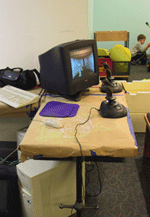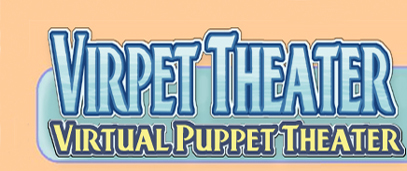USER
TESTING
User
testing proposal
 |
Guest
Testing
A
large part of designing any interactive experience for
children is putting said experiences through the rigors
of repeated playtesting “in the field.” This
is especially important for the Virpets Theater team,
since we have very little in common with our intended
guests. We must examine everything from the input devices
to the backdrops we create from a child’s point
of view. We have developed a preliminary plan to address
this need that includes a minimum of 4 live tests at the
Museum. What follows is an enumeration of said plans along
with an examination of our target audience, as well as
our findings so far. |
Target
Audience & Inherent Challenges
Ours is an exciting challenge – design a technology-heavy
interactive museum exhibit for children from 4-7 years of age.
A few of the unique challenges that our young user base presents:
-
Reading & Writing Ability
? Most children at this age will not be able to read
? Those that are literate will not be sophisticated readers.
- Attention Span
? Children will probably not want to sit through multiple tests.
? Even if they do, they cannot quantitatively express their
preferences.
- Gathering Data
? It is unlikely that written surveys would be effective in
this situation.
? The best way for us to obtain information is observation and
video interview.
- User Consent
? Parents must give permission for children to appear on video.
? Our users are not legally capable of providing permission
themselves.
As
a result, our methodologies will differ somewhat from standard
user testing methods. We will not be attempting to gain quantitative
knowledge from these tests – rather, we will concentrate
on gathering as much from observation as we can. When appropriate
(and permissible), we will also tape interviews with the children
to get their reactions to the system.
Overall
Research Questions:
General
- Are some puppets chosen more than other puppets?
- What do children take away from the exhibit about puppetry?
- Which methods are most effective for conveying information?
- Would a “mascot” be a valuable tutorial tool?
Creative
- How does a backdrop influence a child’s storytelling
capabilities?
- Does a themed set limit their stories to a particular genre?
- What effect does removal of backgrounds have on storytelling?
- How much time do children spend telling stories?
- Are children willing to perform with an unfamiliar child?
Interface
- Is the MS Sidewinder Pro too intimidating as an input device
(joystick)?
- Could simple aesthetic changes make the Sidewinder more appealing?
- Is one joystick sufficient?
- How much functionality do kids need to feel in control?
- How much time do kids spend choosing a character?
Technology
- Can we project puppets and scenes from separate computers?
- How durable are the components? (joystick, screen, mouse,
touchscreen)
- What abnormal demands will children place on the system?
- How much stress can the system handle?
Proposed
Playtesting Schedule
This
schedule is subject to change, especially in regards to the
subject matter concentrations for each test. This is intended
as a rough guide to content creation and materials procurement
so that our team will be fully prepared for each of the tests.
Playtest
1: Week of February 20th
High-Level Goals:
- Observe effect of backgrounds on children’s play
- Observe 2-player dynamic
- Test intuitiveness of joystick interaction
- Basic observations about reactions to interaction
Conditions:
- Minimum of 2 puppets in system
- Minimum of 3 worlds (blank, generic, themed)
- Soliciting kids to play in the world (not walk-up and play)
Materials:
- Minimum 2 laptops or desktops/monitors
- Networking equipment (router, cables, etc.)
- 2 joysticks (one per station)
Playtest
2: Mid-March
High-Level Goals:
- Test potential input schemas for puppets
- Test child-facing UI
- Test revisions from Playtests 1&2
Conditions:
- 1-player or 2-player setup
- Solicited play (not walk-up-and play)
- Child-facing UI in place (puppet / world selection as applicable)
Materials
- Minimum of 4 puppets in system
- 2 joysticks per system
- Minimum 1 control computer, 1 server
Playtest
3: Early April
High-Level
Goals:
- Test educational value of system
- Observe unfettered play on the system
- Preliminary tests of final system
Conditions:
- 2-player setup
- Full system loop (idle, selection, play)
- Tutorial elements in place
- All completed models to date
Materials:
- Recorder for theStage (if possible)
- 3 computers (Server, 2 control)
- Networking equipment
- All communications software
Playtest
4: Late April/Early May
High-Level
Goals:
- Stress-testing final setup
- Enjoyability of final setup
Conditions:
- Setup display area
- Walk-up-and-play (little soliciting)
- All software should be in place
- Most models in place
Materials
- Minimum 3 computers (Server, 2 play stations)
- Large projection screen
- Digital projector
- 2-4 joysticks or other input devices
- Touch Screen displays
Observations from the First Guest Test
February 22, 2003 – Basement of the Children’s
Museum
Conditions:
Technology:
2 Networked systems – 1 client, 1 client/server
1 small monitor for display of world
1 joystick per character
Content:
Same puppet for both players
One world – the old Garvey family “house”
Real “creepy smile” puppet was on display near our
station
Methodology:
Videotaped interactions
Minimal interaction with the children
Answered any questions kids had
Observations:
1. On the joysticks:
a. Kids are not scared of the Sidewinder joysticks.
b. They are quite willing to press all the buttons
i. They watch intently to see what each buttonpress does.
c. They are also willing to abuse the heck out of the joysticks.
d. To some kids, the joysticks seem to suggest a military or
flight-based experience.
2.
On multi-player behavior:
a. Kids were willing to play with strangers as well as their
own parents.
b. Children also shared their knowledge about the controls,
teaching one another.
c. Behavior was often imitative – kids were more willing
to come up and play if someone else was first, and if one child
was rowdy, their compatriot would most likely follow.
d. Some of the best interactions were a parent and child learning
together.
i. Moms were just as willing to play as dads!
3.
On the presentation:
a. Kids didn’t seem to notice that collision detection
wasn’t implemented.
b. The size of the monitor may have been a factor – it
was so small that the joystick almost dominated the experience.
c. Kids wanted the puppets to cross into each other’s
physical spaces.
d. System does not attract people when idle. Need idle animation,
etc.
4.
On storytelling:
a. Children didn’t know that we wanted them to tell stories
i. They thought this was a video game
b. Some kids seemed to be telling one-player stories
c. Having 2 different puppets might help
d. Adults were must more emphatic about the storytelling/roleplaying
5.
On context:
a. The kids that did draw a parallel between the real puppet
and the virtual one were much more interested in the experience.
b. “I want to play with a real puppet now!”
i. Real puppets should be in VERY close proximity in final exhibit
6.
Quirky behavior:
a. Kids universally loved the slider that made the puppets “fly”
i. Closest many got to telling stories




